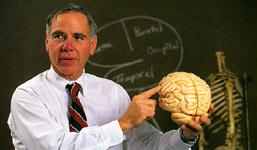

Thomas B. Perera Ph.D.
Click BACK to Return to Dr. Perera's homepage:
Click BACK to Return to Dr. Perera's homepage:
Internet ENIGMA Museum:
COPYRIGHT NOTICE: (Copyright (c) 2023: Prof. Tom Perera Ph. D.)
Professor Emeritus of Psychology
Montclair State University
PHYSIOLOGICAL PSYCHOLOGY / BEHAVIORAL NEUROSCIENCE SYLLABUS:
PHYSIOLOGICAL PSYCHOLOGY / BEHAVIORAL NEUROSCIENCE Dr. Perera
DESCRIPTION: An introduction to the structure (ANATOMY), function
(PHYSIOLOGY), and dysfunction (PATHOLOGY) of the human nervous system.
Beginning with a detailed consideration of the nerve cell, the course proceeds
through the entire peripheral nervous system including the sense organs and
muscles. The central nervous system is then studied in detail from the spinal
cord through the brain. Finally, the involuntary (autonomic) nervous system,
sleep, eating, memory, sexual behavior, biofeedback, and higher mental
functioning are discussed.
Notes: Perera,T.B. Visualized Lecture Notes for Physiological Psychology. MSU.
OPTIONAL:
Texts: Noback,C.R.,Strominger,N.L., & Demarest,R.J. (1996). The human nervous
System. Philadelphia: Lea & Febiger. (5th Edition)
or Noback, C.R. et. al., The Human Nervous System, (4th Edition)
Ref: Netter, F. H. (1958). The Nervous System. (Vol 1). Summit,NJ: Ciba
NETTER NOBACK91 NOBACK96
Lecture Topic Plates Pages Pages
-------------------------------------------------------------------------------
1 Introduction to Physiological Psychology 1-4 vii-xi
2 The Nerve Cell (Anatomy) 15-25 11-27
3 Nerve Cell Degeneration & Regeneration 26-31 27-30
4 Nerve Cell Electrophysiology 33-56 31-57
5 EXAM: The Receptors: Skin & Chemical Receptors 115-157 113-153
6 The Ear: (Anatomy) 251-255 229-237
7 The Ear: (Physiology) 255-268 237-242
8 The Eye: (Anatomy) 297-302 263-269
9 The Eye: (Physiology) 302-317 269-278
10 The Effectors (Muscles) 115-127 113-122
11 The Central Nervous System: Meninges (11-16,21,23) 67-69 67-82
12 The Spinal Cord: (Anatomy) (1-10,26-32) 103-113 103-111
13 The Spinal Cord: (Physiology) (26-32) 115-127 123-137
14 The Spinal Cord: (Afferent Pathways) 129-157 139-153
15 The Spinal Cord: (Efferent Pathways) 159-174 155-167
16 The Spinal Cord: (Lesions & Pathology) (73-104) 175-189 169-179
17 Examination 203-215
18 The Brain: Cranial Nerves, Brain Development 219-237 83-102
83-102 59-65
19 The Brain: Ventricles & Cerebrospinal Fluid (11-19,21-32 57-81 67-82
20 The Brain: General Anatomy & Physiology (17-23) 5-15 1-9
21 The Cerebellum (45-46) 281-296 251-262
22 The Thalamus (18,19,22,23,25,47 361-373 317-328
23 The Brain: (Layers of the Cortex) (48) 397-424 347-368
24 The Autonomic Nervous System: (53-72) 319-332 279-290
The Brainstem: 191-217 181-201
25 The Hypothalamus: (Anatomy & Physiology) (Supp 1-18) 333-348 291-297
26 Stereotaxic Surgical Procedures (Supp 1-18) 349-360 297-304
27 Higher Functions: (Sleep, Sexual Behavior, Timing, etc.) 375-395 305-315
28 The Neurological Examination: (Clinical Procedures) 269-279 329-346
Neurotransmitters: 238-249 217-228
29 Review for Comprehensive Final Examination 243-250
(Note: Some readings overlap)
-------------------------------------------------------------------------------
There will be two hour examinations and a cumulative final examination.
Brain Model: You will construct a 3 dimensional paper and cardboard model of
the human brain from a kit included in the lecture note pack.
Term Paper: (OPTIONAL) A short (5-7 pages double-spaced) paper that critically
and carefully analyzes any topic, research, or disease involving
the structure, function, or pathology of the nervous system.
ON-TIME ATTENDANCE is REQUIRED at all class sessions.
CONTACT INFORMATION
Please Note: IF YOU DO NOT RECEIVE AN ANSWER TO YOUR EMAIL
IT MEANS THAT I CAN NO LONGER RESPOND.
Please use internet search engines to find other information if you do not receive a reply.
Professor Emeritus:
Montclair State University
Internet On-Line Telegraph & Scientific Instrument Museums:
I ask you to type my email address as
follows with no spaces between words:)
Please use internet search engines to find other information if you do not receive a reply.
IF you do not receive a reply my spam cleaner might have intercepted your
email.
Pease try again with a different Subject and Text.
http://w1tp.com
https://EnigmaMuseum.com
Although all the pictures and text are copyrighted, you may use any of them
for your own personal applications including public lectures and
demonstrations, publications and websites as long as you mention the
w1tp.com Museum. If you plan to offer them for sale to the public
in any form, please email me for permission which I will generally grant as
long as you mention my museum: http://w1tp.com or https://EnigmaMuseum.com My email address is
given at the bottom of this page. Some of the material may require contacting
other copyright owners for commercial use and I will inform you by email.
Please also see the Disclaimer of Warranty.